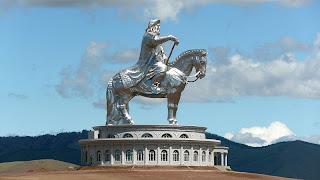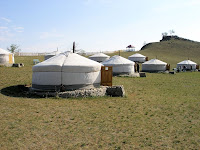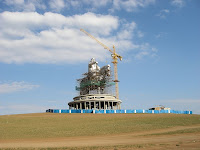A
Trans-Siberian-Mongolian Journey
A
long, long Railway Journey
Part Six: Ulaanbaatar and beyond
by
Gyan C. A. Fernando
Ulaanbaatar
It is the 16th of August and we are now in Ulaanbaatar, the Capital of Mongolia.
We drive for one hour to get to our Gur camp.
 It is a rather touristy place, but later we visit a local, real Gur camp and find modern day nomads with satellite TV and four-wheel drive vehicles!
It is a rather touristy place, but later we visit a local, real Gur camp and find modern day nomads with satellite TV and four-wheel drive vehicles!
The setting is nice. It is a vast open totally tree-less space with gently undulating hills.
There is a nice valley with a shallow river with clear blue water. In the far distance are high mountains.
Genghis Khan is Everywhere!
We are near the massive stainless steel statue of Genghis Khan on horseback, at Tsonjin Boldog on the banks of the River Tuul and 54 Km east of Ulaanbaatar. The statue was still under construction at that time, but has now been completed.
Nearby, was the false Great Wall built by the BBC for a TV programme.

We relax after our long train journey.
Our guide arranges for us to visit the real Gur camp where we are treated to mares' milk, yoghurt and dried yoghurt. The latter tastes vile!
Later we play with the local children.
The food in our camp is good. Mostly meat with the stew being cooked in traditional fashion, that of chucking heated stones into the stew! This is probably a touristy thing. Apparently, it is only used on special occasions nowadays
.
Mongolians also eat horse meat which is understandable as they raise horses.
On the 18th of August we moved back to Ulaanbaatar and into the Hotel Voyage. With our guide Oran and her younger brother, we explore the city. Later in the evening we go for a cultural show.
There is an open-air static display of old steam locomotives close to the Railway Station. Unfortunately, I did not have time to visit but only saw it in passing.
Back on the train
The next morning, the 19th of August at 0805 hrs we re-board the Trans-Mongolian, Train N 004. It is a rather wet day. I share a compartment with Esther, Nigel and Maggie.
We stop at Choyr where the local boys offer what appears to be pieces of Jade. We are on the Gobi Desert which is known to be strewn with fragments of Jade.
Late that night we get to Dzamyn Ude which is the Mongolian border town with China. The formalities here were not too bad. We stopped there at 1926hrs and left at 2035 hrs, a stop of 01.09 hrs.
We then move across a no-man's land to Erlian on the Chinese side. We got there at 2100hrs but the border formalities took a long time.
This is where I was questioned about the Tibetan stamp on my passport!
Changing of the Gauge
One of the problems at this border crossing between Mongolia and China, is the change in the railway gauge.
Mongolia runs on the same gauge as Russia, but China uses the more common Standard Gauge.
For the trains to run through, the bogies of the train are changed here. In the past, passengers apparently were allowed to observe this ceremony but this is no longer possible.
We spent our time on the platform eating, drinking, dancing and observing the huge Chinese diesel electric shunters.
All in all, by the time we left Erlian, it was 0057 hrs. and we were into the next day.
We are still on the Gobi Desert and the landscape is the same.
There are a few more intermediate stops.
The landscape now changes dramatically. We are now in a mountainous region and we pass through tunnels and viaducts.
Eventually, on the 20th of August, at 1404 hrs, we arrive at Beijing Central Station.
It is the end of a long railway voyage.
Copyright: Gyan C. A. Fernando, 2012
 The photographs belong to the author and are copyright except for the completed statue of Genghis Khan on horseback (Brucke Osteuropa, public domain)
The photographs belong to the author and are copyright except for the completed statue of Genghis Khan on horseback (Brucke Osteuropa, public domain)
More pictures available here: Picasa
by
Gyan C. A. Fernando
Ulaanbaatar
 |
| Massive statue of Genghis Khan |
It is the 16th of August and we are now in Ulaanbaatar, the Capital of Mongolia.
We drive for one hour to get to our Gur camp.
 |
| Our Gur camp |
 It is a rather touristy place, but later we visit a local, real Gur camp and find modern day nomads with satellite TV and four-wheel drive vehicles!
It is a rather touristy place, but later we visit a local, real Gur camp and find modern day nomads with satellite TV and four-wheel drive vehicles!The setting is nice. It is a vast open totally tree-less space with gently undulating hills.
There is a nice valley with a shallow river with clear blue water. In the far distance are high mountains.
Genghis Khan is Everywhere!
We are near the massive stainless steel statue of Genghis Khan on horseback, at Tsonjin Boldog on the banks of the River Tuul and 54 Km east of Ulaanbaatar. The statue was still under construction at that time, but has now been completed.
Nearby, was the false Great Wall built by the BBC for a TV programme.

 |
| Genghis Khan under construction |
Our guide arranges for us to visit the real Gur camp where we are treated to mares' milk, yoghurt and dried yoghurt. The latter tastes vile!
Later we play with the local children.
The food in our camp is good. Mostly meat with the stew being cooked in traditional fashion, that of chucking heated stones into the stew! This is probably a touristy thing. Apparently, it is only used on special occasions nowadays
.
Mongolians also eat horse meat which is understandable as they raise horses.
On the 18th of August we moved back to Ulaanbaatar and into the Hotel Voyage. With our guide Oran and her younger brother, we explore the city. Later in the evening we go for a cultural show.
 |
| Ulaanbaatar Station |
 |
| The Trans-Mongolian arrives at Ulaanbaatar |
Back on the train
The next morning, the 19th of August at 0805 hrs we re-board the Trans-Mongolian, Train N 004. It is a rather wet day. I share a compartment with Esther, Nigel and Maggie.
We stop at Choyr where the local boys offer what appears to be pieces of Jade. We are on the Gobi Desert which is known to be strewn with fragments of Jade.
 |
| Boy selling jade at Choyr |
We then move across a no-man's land to Erlian on the Chinese side. We got there at 2100hrs but the border formalities took a long time.
This is where I was questioned about the Tibetan stamp on my passport!
Changing of the Gauge
One of the problems at this border crossing between Mongolia and China, is the change in the railway gauge.
Mongolia runs on the same gauge as Russia, but China uses the more common Standard Gauge.
 |
| Erlian Station |
 |
| Erlian Station |
All in all, by the time we left Erlian, it was 0057 hrs. and we were into the next day.
We are still on the Gobi Desert and the landscape is the same.
There are a few more intermediate stops.
The landscape now changes dramatically. We are now in a mountainous region and we pass through tunnels and viaducts.
Eventually, on the 20th of August, at 1404 hrs, we arrive at Beijing Central Station.
It is the end of a long railway voyage.
Copyright: Gyan C. A. Fernando, 2012
Illustrations:
 The photographs belong to the author and are copyright except for the completed statue of Genghis Khan on horseback (Brucke Osteuropa, public domain)
The photographs belong to the author and are copyright except for the completed statue of Genghis Khan on horseback (Brucke Osteuropa, public domain)More pictures available here: Picasa
Further
Reading:
- The Trans-Siberian Railway (Wikipedia): http://en.wikipedia.org/wiki/Trans-Siberian_Railway
- The Practicalities (Wikitravel): http://wikitravel.org/en/Trans-Siberian_Railway
- The Trans-Siberian Route: http://www.waytorussia.net/TransSiberian/Route.html
- Ulan Ude: http://en.wikipedia.org/wiki/Ulan-Ude
- The Trans-Mongolian: http://en.wikipedia.org/wiki/Trans-Mongolian_Railway
- Naushki: http://en.wikipedia.org/wiki/Naushki
- Mongolian Cuisine: http://en.wikipedia.org/wiki/Mongolian_cuisine
- Mongolian Recipes: http://www.mongolfood.info/en/
No comments:
Post a Comment